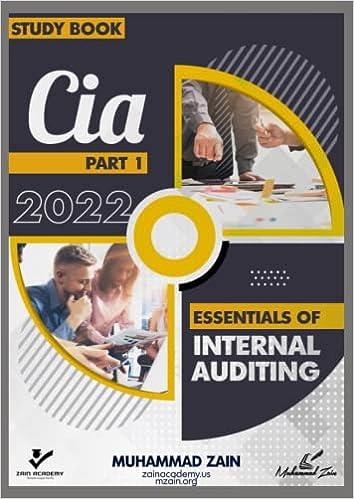

The following information pertains to Greenwich Company. Balance Sheet Assets Year 2 Year 1 Cash and short-term investments $ 45,000 $ 35,000 Accounts receivable (net) 25,000 25,000 Inventory 20,000 20,000 Capital Assets (net) 210.000 215,000 Total Assets $300.000 $295,000 Liabilities and Shareholders' Equity. Current liabilities $ 60,000 $70,000 Long-term liabilities 90,000 90,000 Shareholders' equity 150.000 135,000 Total liabilities and shareholders' equity $300,000 $295.000 Statement of Earnings Sales $ 80,000 Cost of goods sold 45,000 Gross margin 35,000 Operating expenses 20.000 Net earnings $ 15,000 Weighted average number of common shares 6,000 Market price per common share $20 Depreciation, included in operating expenses $5,000 Required: 1) You are a banker considering a short-term bank loan of $50,000 for Greenwich Company: a) choose the 3 ratios that you believe to be most appropriate in this situation, b) indicate the reason for each choice (not just a description of the ratio), c) calculate each of your chosen three ratios for year 2. Ratio formulae are provided below. 2) Based on your answer to required 1), above, would you grant the company the loan? Explain briefly & clearly, why or why not. Ratio Formula Working capital Current assets - Current liabilities Current ratio Inventory turnover Days in inventory Current assets Current liabilities Cost of goods sold Average inventory 365 days Inventory turnover Net credit sales Average gross accounts receivable 365 days Receivables turnover Receivables turnover Average collection period Cash current debt coverage Cash provided (used) by operating activities Average current liabilities Ratio Debt to total assets Free cash flow Formula Total liabilities Total assets Cash provided (used) by operating activities - Net capital expenditures - Dividends paid Earnings before interest expense and income tax expense (EBIT) Interest expense Cash provided (used) by operating activities Average total liabilities Times interest earned Cash total debt coverage Ratio Earnings per share Formula Net earnings available to common shareholders Weighted average number of common shares Market price per share Earnings per share Price-earnings ratio Gross profit margin Gross profit Net sales Profit margin Net earnings Net sales Return on assets Net earnings Average total assets Net sales Average total assets Asset turnover Payout ratio Cash dividends Net earnings Dividend per share Market price per share Dividend yield Return on common shareholders' equity Net earnings available to common shareholders Average common shareholders' equity The following information pertains to Greenwich Company. Balance Sheet Assets Year 2 Year 1 Cash and short-term investments $ 45,000 $ 35,000 Accounts receivable (net) 25,000 25,000 Inventory 20,000 20,000 Capital Assets (net) 210.000 215,000 Total Assets $300.000 $295,000 Liabilities and Shareholders' Equity. Current liabilities $ 60,000 $70,000 Long-term liabilities 90,000 90,000 Shareholders' equity 150.000 135,000 Total liabilities and shareholders' equity $300,000 $295.000 Statement of Earnings Sales $ 80,000 Cost of goods sold 45,000 Gross margin 35,000 Operating expenses 20.000 Net earnings $ 15,000 Weighted average number of common shares 6,000 Market price per common share $20 Depreciation, included in operating expenses $5,000 Required: 1) You are a banker considering a short-term bank loan of $50,000 for Greenwich Company: a) choose the 3 ratios that you believe to be most appropriate in this situation, b) indicate the reason for each choice (not just a description of the ratio), c) calculate each of your chosen three ratios for year 2. Ratio formulae are provided below. 2) Based on your answer to required 1), above, would you grant the company the loan? Explain briefly & clearly, why or why not. Ratio Formula Working capital Current assets - Current liabilities Current ratio Inventory turnover Days in inventory Current assets Current liabilities Cost of goods sold Average inventory 365 days Inventory turnover Net credit sales Average gross accounts receivable 365 days Receivables turnover Receivables turnover Average collection period Cash current debt coverage Cash provided (used) by operating activities Average current liabilities Ratio Debt to total assets Free cash flow Formula Total liabilities Total assets Cash provided (used) by operating activities - Net capital expenditures - Dividends paid Earnings before interest expense and income tax expense (EBIT) Interest expense Cash provided (used) by operating activities Average total liabilities Times interest earned Cash total debt coverage Ratio Earnings per share Formula Net earnings available to common shareholders Weighted average number of common shares Market price per share Earnings per share Price-earnings ratio Gross profit margin Gross profit Net sales Profit margin Net earnings Net sales Return on assets Net earnings Average total assets Net sales Average total assets Asset turnover Payout ratio Cash dividends Net earnings Dividend per share Market price per share Dividend yield Return on common shareholders' equity Net earnings available to common shareholders Average common shareholders' equity








